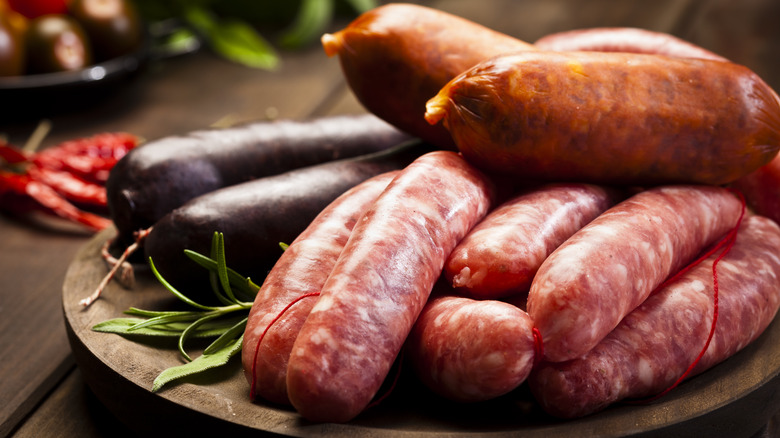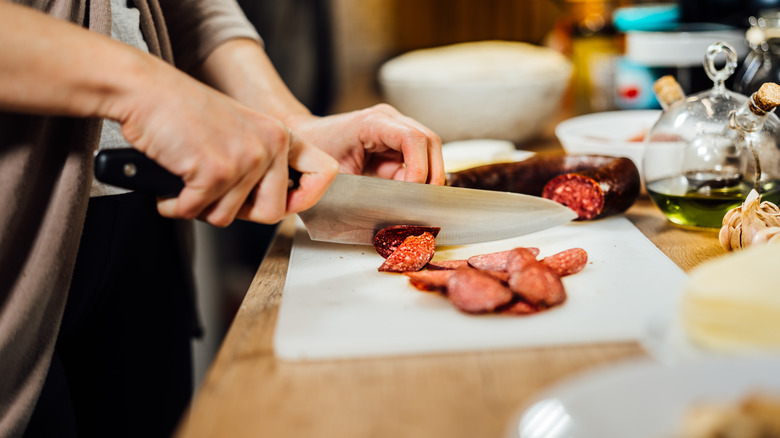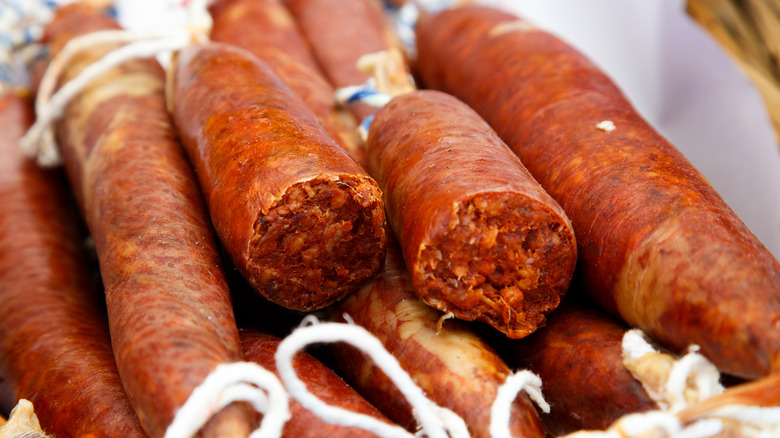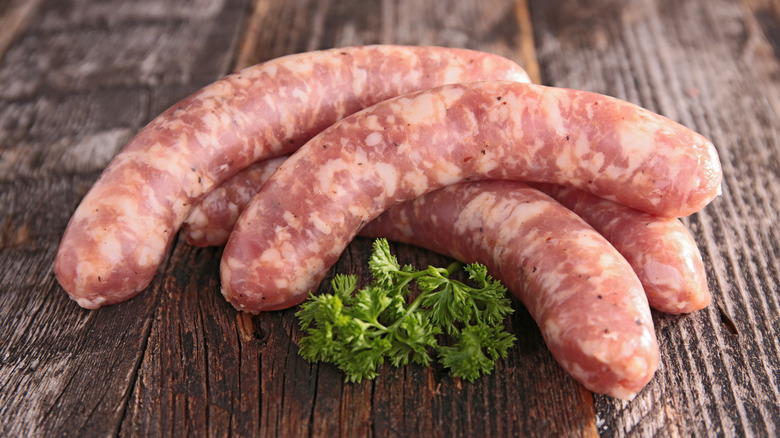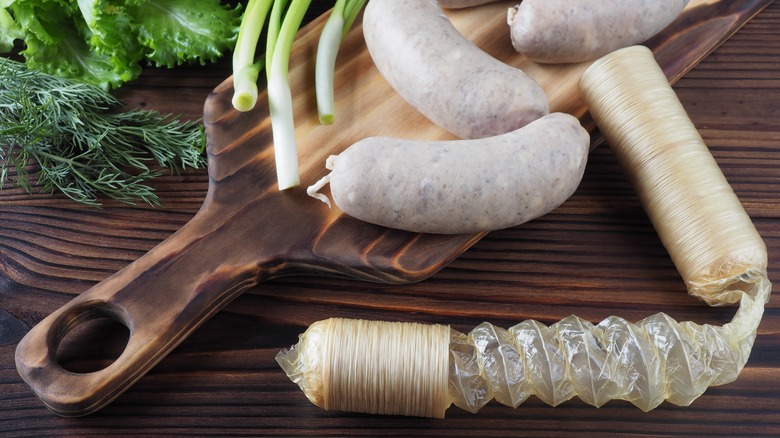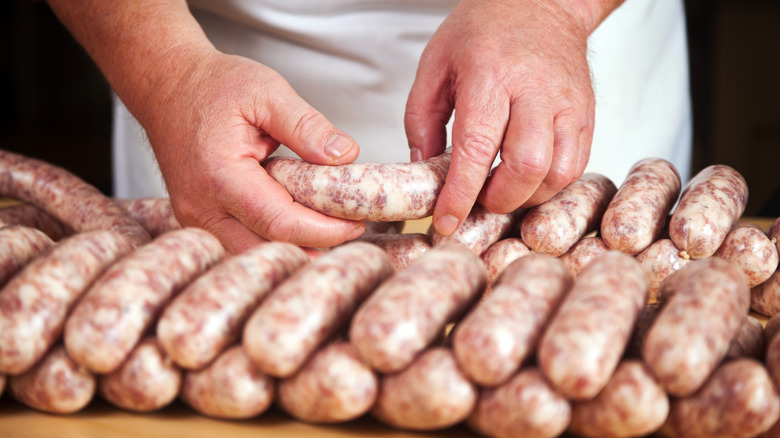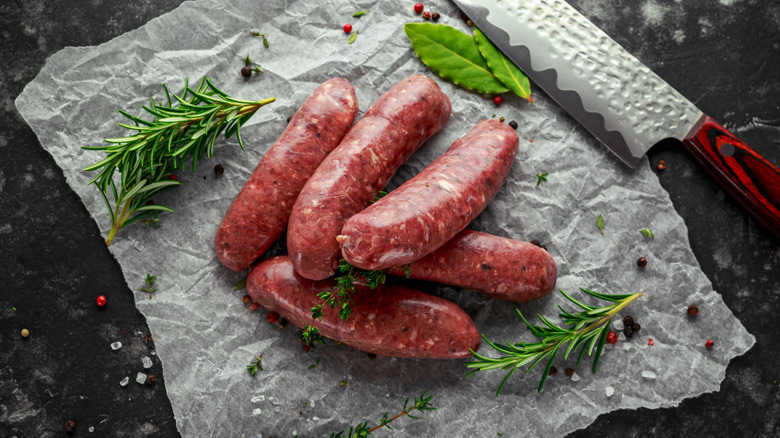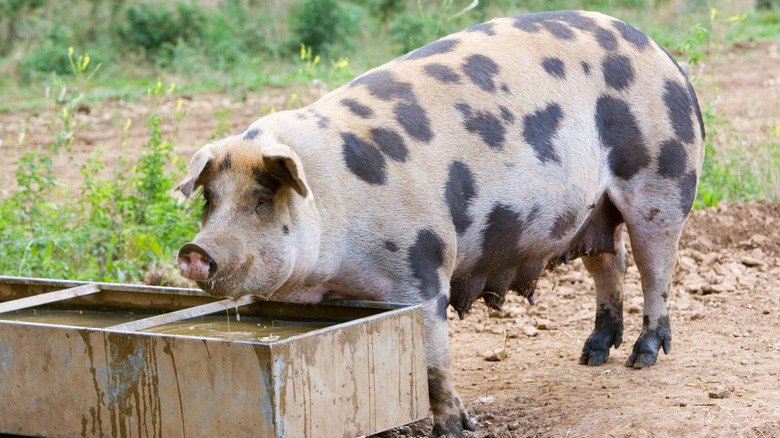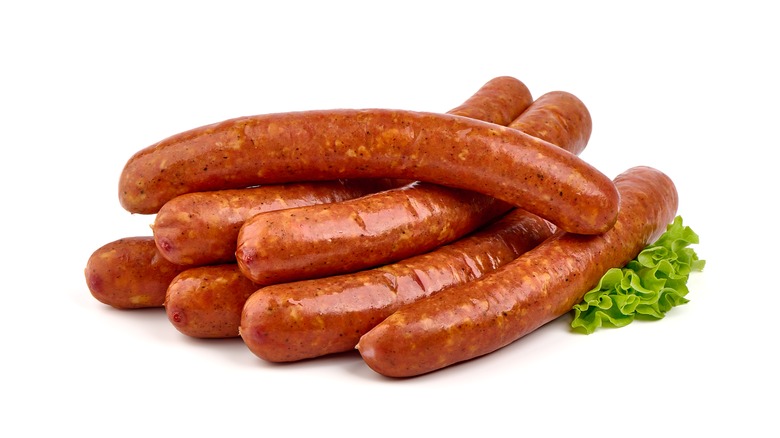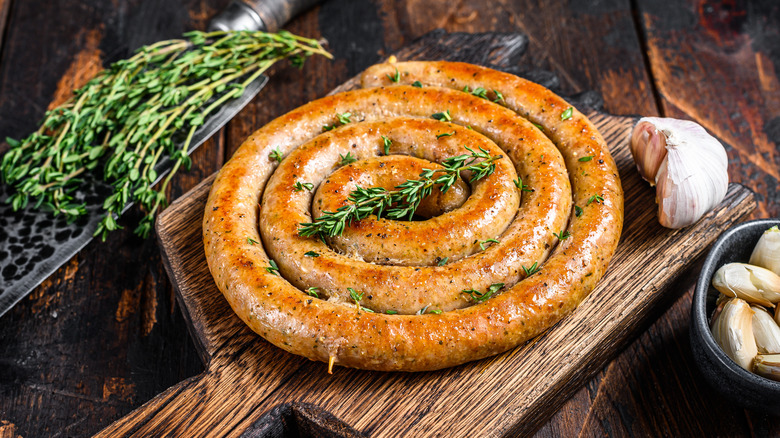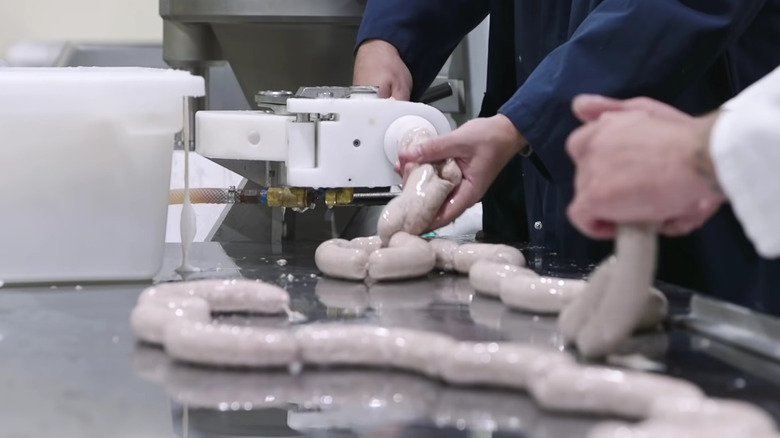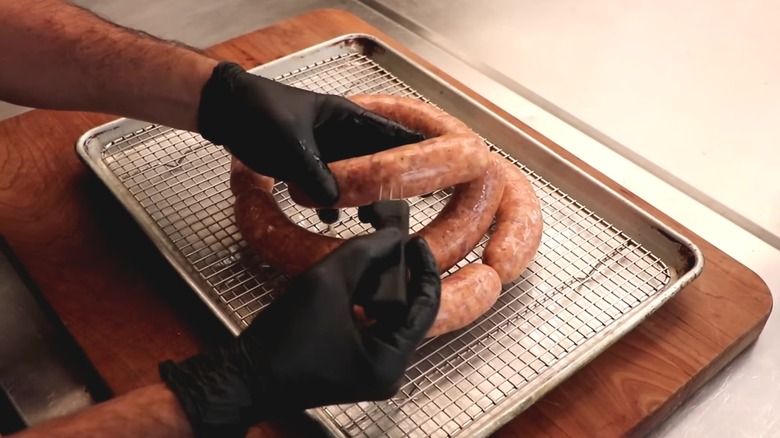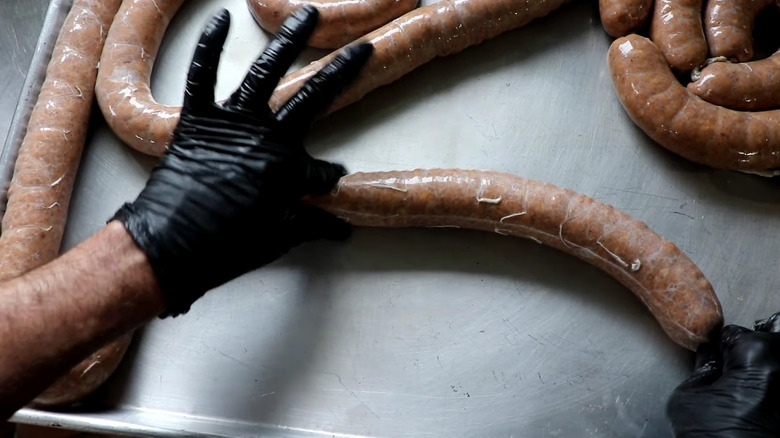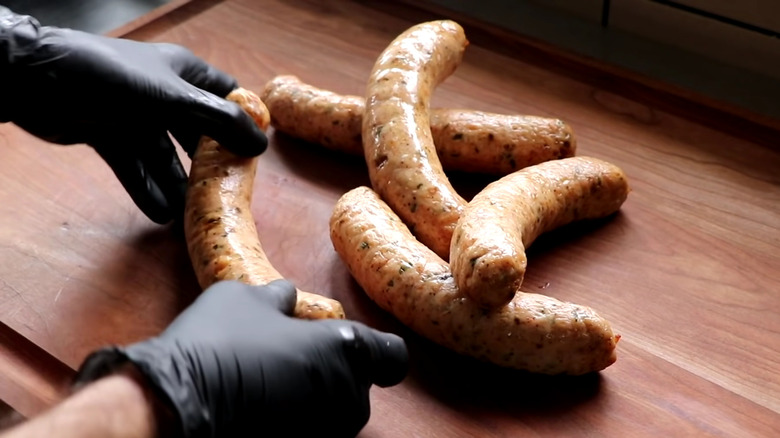The Ultimate Guide For Buying Sausage
In the modern day, the popularity of sausages in the United States has led to a slew of such products cluttering the nation's stores. Unfortunately, this range of choices makes it difficult to discern between sausages of poor and good quality, but in this article, we offer some advice to help you make this important distinction, examining everything from overstuffing to casing quality.
Disparate societies from all around the globe have created and eaten sausages on a massive scale for thousands of years, and thanks to the plethora of cultures that call the U.S. home, the country has enjoyed a huge variety of sausages ever since its founding. Over the years, immigrants from Europe, Asia, Africa, and both Americas have all brought their own sausages to the nation, kick-starting a sausage industry that is both diverse and innovative. This is reflected in the abundance of sausage varieties found in the U.S. today — an abundance that means most Americans have many things to consider when buying sausages.
Be wary of nitrites and nitrates
Sausages have a reputation for being an unhealthy food. Their notoriously high fat levels undoubtedly play a part in this. However, of greater concern is the association between sausages and cancer risk. According to a study published in the International Journal of Epidemiology, the regular ingestion of processed meat — a category which includes sausages – was found to have a positive association with certain cancers. After examining 474,996 participants, researchers found that eating 70 or more grams of red and processed meat per day led to a 32% greater risk of developing colorectal cancer and a 40% greater risk of developing colon cancer. The link between sausages and certain cancers is thought to be partly due to additives, specifically nitrites and nitrates.
Nitrites and nitrates are used to preserve sausages. They help prevent the spread of potentially harmful bacteria such as Clostridium botulinum and also ensure the sausage develops an appealing, bright color. Unfortunately, nitrites' use also results in the formation of N-nitroso compounds, which are known to be carcinogenic. When consumed alongside protein-rich foods, the nitrates found in sausages form nitrosamines, which are also associated with an elevated risk of developing certain cancers.
Those wishing to continue eating sausage regularly while also minimizing the effects of these additives can purchase nitrite- and nitrate-free sausages. Happily, products of this nature are widely available.
Try sausages that have protected designation of origin status
One of the challenges facing intrepid sausage buyers is that the food's appearance reveals little about how and where it was made. As such, buying sausages sometimes feels like committing a blind act of faith, but this needn't be the case, thanks to an abundance of sausages that meet strict stipulations as to how they are produced and what they contain.
Certifications are a means of producers providing guarantees to consumers. The most well known of all these certifications is the European Union's protected designation of origin, a geographical indication that protects the integrity of various food products. Sausages that are made with PDO status — or equivalent certifications — are manufactured under specific regulations. For example, the Cumberland sausage, which was granted PDO status in 2011, must be made from at least 80% meat, be no more than 5% water, and can only be produced in the English county of Cumbria. These standards not only result in an excellent finished product but also ensure that customers know exactly what they are purchasing.
Other PDO sausages abound in Europe, including Italy's Calabria sausage and Spain's sobrasada. Unfortunately, the United States does not have similarly comprehensive certifications when it comes to sausages.
Make sure they have a high meat content
In the United States, pork, breakfast, and roasted sausage do not have a legal protein requirement. This means there is no minimum amount of meat they are required to contain in order to be labeled and marketed as sausage. Due to the lack of a legal protein requirement, the onus is on the general public to check the meat content of sausages before purchasing them.
Sausages with a high meat content, above 90%, are firm and often thought to be desirable. However, such high concentrations of meat do result in characteristics that aren't always popular. Simon Wood, who was the manager of a meat company, explained this to The Guardian: "When we started, we tried to convert people to eating firmer sausages with 95% to 98% meat that were just seasoned with salt and pepper, but it soon became clear that a lot of people preferred them with a softer texture and a bit more flavour."
As Wood hints, sausages with around 75% meat content are often deemed the best. This amount provides the sausage with plenty of flavor and body while still allowing ample space for the addition of fat, rusk, water, spices, and any other additional ingredients required for a high-quality eating experience.
Take the casings into account
Unless they come in the form of patties, all sausages are wrapped in a casing. Despite the casings' ubiquity, many customers overlook how important they are to the eating experience; they dictate many of the sausage's characteristics, including how robust they are and what texture they offer when bitten into.
There are two main types of casing: natural and collagen. Natural casings are made from the cleaned small intestines of various animals, including hogs, cows, and even elk. They are the traditional means of encasing sausages and are a fantastic way to use up an oft-discarded part of animal carcasses. Small intestines from different types of animals vary in size. For this reason, larger sausages are usually made with hog casings and smaller ones with sheep casings. Natural casings also provide some practical benefits. For example, they are said to be more permeable than collagen casings. When smoked or otherwise cured, this permeability allows more flavor to penetrate the sausage meat.
Collagen casings are man-made and have their own benefits. They're thought to lend the sausage a better snap when bitten into and are incredibly uniform in shape, size, and thickness. Naturally, this results in a uniform sausage being produced.
Get them from local butchers
Great sausages are found across the country in all types of stores. Despite this, we advise buying sausages from your local butcher when possible. This is for a few reasons. Firstly, purchasing sausages from local butchers gives customers the opportunity to inquire about the animals. Due to their close ties with suppliers, butchers will likely know where the animals were raised and under what conditions. Butchers can also give advice on how to best cook and serve different types of sausage, knowledge which is hard to come by in the nation's larger grocery stores.
Generally speaking, sausages that are purchased from local butchers also tend to be of a higher quality than the mass-produced products found in large grocery stores. This is because they are often freshly made, using locally reared animals. Cheap sausages produced and distributed on a mass scale rarely boast similar virtues.
Check the fat content
The United States Department of Agriculture has clear laws regarding the fat content of sausages produced in the U.S. Products labeled as fresh pork sausages, breakfast sausages, and whole hog sausage cannot contain more than 50% fat by weight. The legal limit for sausages labeled as Italian and fresh beef sausages are somewhat lower, standing at 35% and 30% of total weight, respectively.
Fat plays a vital role in sausages, providing both moisture and flavor. Because of this, lean sausages often taste bland and can easily dry out during cooking. That being said, sausages with a high fat content — around 50% — tend to be overly greasy, and regular consumption of them can pose health risks. Consequently, most butchers advise buying sausages with a fat content between 25 and 30%. Producers attain this fat content by using fatty cuts of meat, such as pork belly, to make the sausage. Occasionally, additional fat, or sometimes even cheese, is added to further raise the sausage's fat content.
Consider sausages made from heirloom breeds
The vast majority of pork sausages are made using the meat of commercially farmed pig breeds, predominantly the Yorkshire. These animals are known to produce lean carcasses that maximize yields and thus profit margins. However, some pig farmers and butchers prefer to use heirloom breeds to make sausages, such as the Berkshire and the Gloucestershire old spot (pictured). Chef Craig Deih explained why some producers turn to these animals to the Charleston City Paper: "The heritage breeds have more characteristics and flavorful fat. If you start with a better product, you'll end up with a better product."
Thanks to their unique genetic makeup, heirloom tomatoes offer a huge abundance and variety of flavor. Heirloom pigs are the same, boasting incredibly flavorful fat. The resulting sausages are far superior to anything else on the market.
The only drawback of heirloom sausages is their price. Heirloom breeds take longer to mature than commercial breeds and tend to have a much more varied, and therefore expensive, diet. Add to this the time- and space-consuming rearing practices that are often employed, and it's not difficult to see why sausages made from heirloom breeds can cost more than $20 per pound. Rest assured, however, that buying them is money well spent.
Try sausages from a variety of cultures
The array of sausages that are available in the United States is truly breathtaking. Despite this, many Americans continue to buy and eat a small selection of them, often rotating between bratwurst, Italian, and breakfast. There's no doubt these three are excellent types of sausage. Yet, relying on these three alone sees the American public overlooking many other types of sausage that boast enticing flavors and textures of their own.
Take, for example, merguez. These North African sausages are long, thin, and traditionally made with a mixture of lamb and beef. Thanks to an abundance of spices and flavorings, including harissa, a spicy paste that's popular in North Africa, merguez offers an intense flavor that few other sausages can rival. Using merguez in place of other sausages is a simple, surefire way to elevate a meal.
Another sausage that is frequently overlooked by Westerners is sai ua, a flavorful Thai sausage that contains pork, lemongrass, and makrut lime leaves. Thanks to these ingredients, sai ua has a pronounced zing that other sausages lack. For this reason, it's a wonderful sausage to enjoy with a host of foods.
Don't automatically reach for links
When most people buy sausages, they get links. This is the most common form of sausage, but it's far from the only. Another common style are sausage patties, made from sausage filling that's not contained by a casing. Instead, the meat forms a puck-like shape. Often fried up at breakfast, sausage patties offer some benefits that encased sausages do not. As chef Brian Doherty noted to St. Louis Magazine, "I like to get a good sear, which produces some serious char and texture. And I've always been a fan of a good breakfast sandwich, and patties work much better for that."
Another less utilized sausage form is the coil. These large sausages are often dismissed as being impractical to serve because, unlike links, they don't come in portioned sections. However, an advantage of coiled sausages is that they have a relatively small surface area to volume ratio. This minimizes moisture loss, ensuring that the finished, cooked sausage is much juicier than those cooked as links. So, if catering for a crowd, consider coiled sausages.
Watch out for overstuffed sausages
Overstuffed sausages appear as taut, often bulging cylinders. Another telltale sign of overstuffing is meat leaking from the ends of the sausage. Although buying overstuffed sausages means you get more meat for your money, they are best avoided. This is because overstuffed sausages invariably result in a poor eating experience. Usually, the meat escapes from the casing, causing the sausage to fall apart and cook unevenly. Overstuffed sausages are also prone to bursting, especially when cooked at high temperatures.
If you happen to purchase overstuffed sausages by accident, we advise you remove the meat from the casing and form patties with it. Failing this, the sausages should be cooked as gently as possible, either by steaming or with a sous vide. This minimizes the chances of them bursting. Of course, sausages cooked in this manner will lack that moreish, caramelized surface so many of us love. Just be wary of possible explosions if you grill the sausages.
Avoid sausages that have air bubbles
Competent sausage makers are able to stuff their products with next to no air entering the casing. They also make a habit of pricking the raw sausages to release any air that does make its way into the otherwise finished product. This is important, as trapped air bubbles detrimentally affect all types of sausages. One of the main ways air bubbles ruin an otherwise perfectly good sausage is causing it to cook unevenly; air is a poor conductor of heat, and those sections around the bubbles will cook much slower than those parts of the sausage in contact with the skillet.
The presence of air bubbles also increases the chance that the sausages will burst during cooking as the air inside the sausage expands. To minimize the chance of air-bubbled sausages bursting, customers can prick a hole in the sausage's casing while it cooks, allowing the air to escape. Unfortunately, this causes the sausage's juices to escape as well and can even lead to the entire sausage splitting.
Air pockets inside cured or already cooked sausages, such as salami, do not pose as much of a problem. However, they do mean that customers are getting less sausage for their money. For these reasons, all types of sausage that present air bubbles should be passed over if possible.
Only buy links of a consistent length
Sausages vary greatly in both length and weight; large bratwursts, which are best grilled and braised, are just as common as 25-gram chipolatas. A person's individual preferences determine what size of sausage they favor. But regardless of which size they choose, all sausages of that specific type should be of a consistent length.
To put it simply, linked sausages that vary in length from one to the next indicate shoddy workmanship. If they were tied by hand, varying lengths reveal that the person who made them was either inexperienced or not paying attention. When the sausages were linked via machine, such inconsistencies point to faulty equipment or too little filling being used.
Aside from cooking at varying rates, links of an inconsistent length also suggest that the sausages may suffer from other issues associated with poor workmanship, such as under-seasoning. As a result, they are best avoided.
Don't discount poultry sausages
In the United States, the two most common meats used to make sausages are pork and beef. These classic choices are used to produce bratwurst and Italian sausages. Popular as these meats are, they are by no means the extent of sausage meat options, as the popularity of poultry sausages indicates.
Chicken sausages are undoubtedly the leader of the poultry sausage subcategory. The main appeal of chicken sausages — and those made from other forms of poultry — is that they are significantly lower in fat than those made with pork. Typical chicken sausages contain only around 10 grams of fat total per 100-gram serving. For pork sausages, this number sits at over 27 grams. As Karen Whitman, owner of Mama's Chicken food market in Los Angeles, explained to the LA Times, these credentials cause customers to switch from pork and beef sausages to chicken. "[In the late 1980s] beef had a bad rap, so folks gravitated toward chicken [sausages]. That's really how it became popular, because you were eating something that tasted great and was better for you."
As Whitman indicates, poultry sausages are also surprisingly flavorful. This is thanks to the widespread use of thigh meat, which has a perfect meat-to-fat ratio for sausages, and poultry's ability to take a whole host of seasonings.
